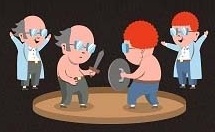Employees sometimes drive to work,
And then they find a parking spot,
Sometimes on a busy street,
Sometimes in a parking lot,
But injuries can still occur,
Between their cars and the front door,
And who will pay for slips and falls,
Will always be the Judge’s call.
Such is the nursery rhyme sung to children of applicants’ attorneys and defense lawyers in the dark and murky world of California workers’ compensation.
This issue came up recently while I was having lunch with my brother-in-law, Jasper. Jasper had been doing well recently in the wheel-barrel industry, and wanted to expand his operations from his garage to a real factory. He invited me to lunch to present me with some exciting investment opportunities in the wheel-barrel industry. Currently, Jasper had his eye set on one location in particular because it came with a parking lot.
His plan was to set up a series of obstacles in the parking lot, in the hopes that the employee with poor agility and balance would sustain injury outside his factory and shield him from workers’ compensation liability. Thus, only the workers that could swim faster than sharks, swing over quick-sand pits, and tight-rope over mine-fields would actually make it to work.
Without getting into issues of Serious and Willful Misconduct, for those readers out there that aren’t Jasper, when you’re facing a claim of injury in or near a parking lot, are you on the hook? Let’s start with the basics.
In order for an injury to fall within the scope of California’s workers’ compensation system, as opposed to general civil tort, the injury must arise out of and occur within the course of employment. (See Labor Code section 3600.) This is commonly referred to as AOE/COE. Generally speaking, injuries sustained during the regular commute to or from work are not compensable, unless they fit into one of several exceptions.
But what about that last stretch of travel, between the car door and the building door?
In the case of Lewis v. WCAB, Lewis parked in a lot leased for employees. Walking down the street to her office, three block away, she fell. In finding the claim compensable, the Supreme Court reasoned that there is a “reasonable margin of time and space necessary to be used in passing to and from the place where the work is to be done” included within the scope of employment.
The Court went further, noting that once the employee enters the premises under the control of the employer, including employer-owned parking lots, the commute has ended and the scope of employment has begun. (See Santa Rosa Junior College v. WCAB, footnote 11.)
By providing an employee parking lot, Jasper could very well find himself increasing his liability with every square foot of parking under his control.
At this, Jasper got nervous and decided his plan would have to be changed. Instead, he would have his employees park on the street and use the entire lot for more obstacles. After all, he read an article in Wheel Barrels and Workers’ Comp., a very limited-circulation magazine which only exists in this story, which discussed a similar idea. There, the article’s author discussed two cases.
The first, an unpublished decision by the Court of Appeal, was Sharp Coronado Hospital v. WCAB. There, the Court held that an employee asked by its employer to park on the street instead of the parking lot was precluded from recovering for an injury sustained while walking from the employee’s parked car to the hospital. The other, General Insurance Co. v. WCAB, held that an employee struck while crossing the street from his parked car to work could not recover because of the going and coming rule.
Furthermore, he had heard his friend, an applicants’ attorney, grumbling about the panel decision in the case of Sharon Ewegemi v. Oakland Unified School District. In that case, he understood, a teacher had parked her car on the street and was just a few feet from the door of her school when she turned back to get some papers from her car. Walking to her car, she tripped and fell in the street.
In denying her application, the Workers’ Compensation Appeals Board reasoned that, until she entered the school and began working, she was still engaged in her commute, even up to a few feet away from the school.
Jasper’s new plan could put all this into use, he though, by having his employees cross the obstacle course before entering the front door.
Now, bear in mind, dear readers, this is my brother-in-law, so things had to be stated delicately, or else every Thanksgiving Dinner would include Jasper mumbling about how he hopes I come see his snake-pit. So, I had to explain that his new idea wouldn’t exactly work, either.
Why wouldn’t Jasper’s idea work? Come back Wednesday to find out!

